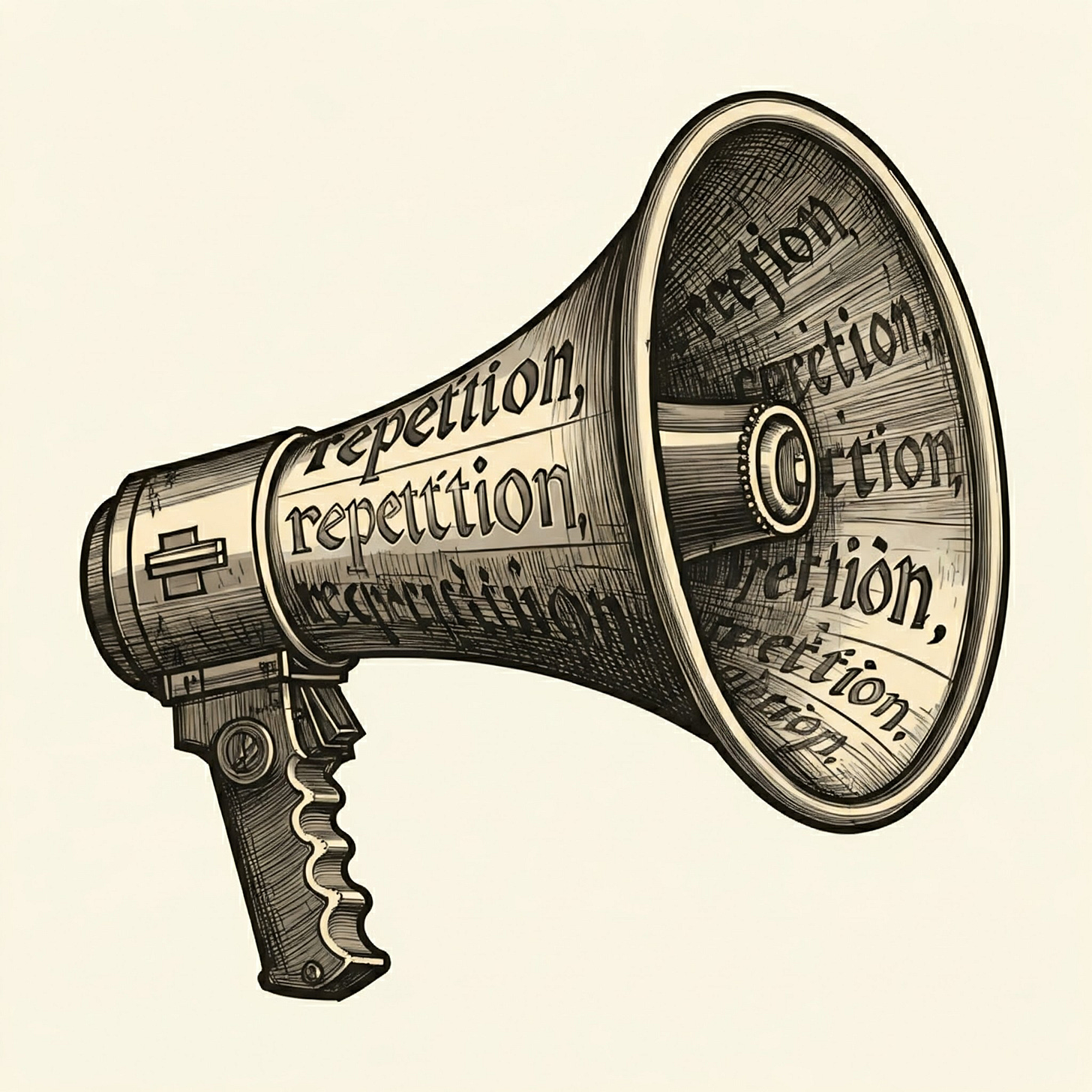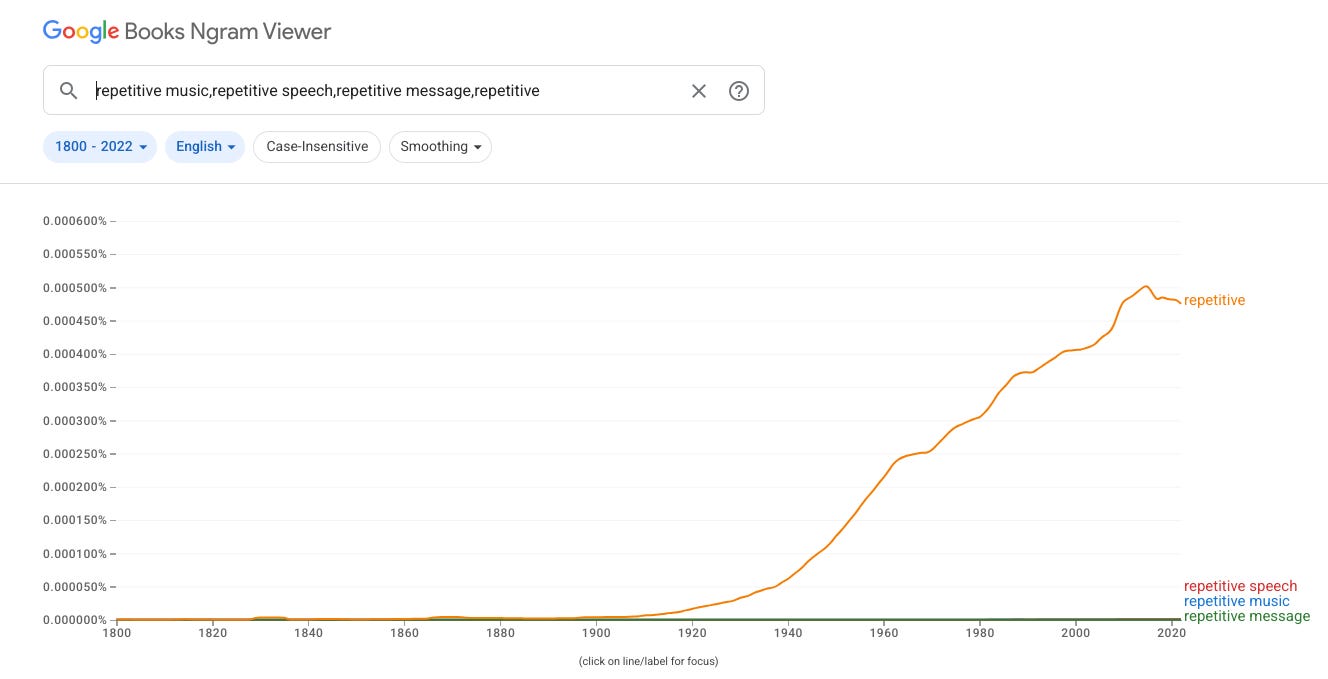The Joy of Repetition
A great message should feel like singing your best karaoke song, because you're going to have to say it 1000 times over the next year.
James Carville, on top of being the Clinton campaign manager who gave us the concept of the War Room, is a great political phrase maker and a great thinker about messaging.
In his recent oped outlining why Democrats should focus on the economy, he mixes up about 300 cliches in a weirdly powerful way, and I loved this sentence: “We know Republicans will most likely skyrocket everyday costs with slapstick tariffs.” At 80, the guy can still lodge two words into your head that 1000 policy papers cannot.
Almost as an aside, he used a word in a totally weird way, but, when I thought about it, felt exactly what I’ve struggled to say: there is a real art in being repetitive.
To win back the economic narrative, we must focus on revving up a transformed messaging machine for the new political paradigm we now find ourselves living in. It’s about finding ways to talk to Americans about the economy that are persuasive. Repetitive. Memorable. And entirely focused on the issues that affect Americans’ everyday lives.
As a four-word definition of a great message, I can’t think of a better one than
Persuasive: are you a credible person and it is a credible fact?
Memorable: can the person who hears it repeat it four days later?
Entirely Focused: a good test of focus is to count how many good things this message is NOT saying. Focus is a choice.
Repetitive: can you say it over and over and over and over and over and over and over again? And then over again.
And then over again.
Getting REPETITIVE is hard but it is the one quality that will make the other qualities of a great message works.
Why you want to be repetitive repetitive repetitive
Most thought leadership efforts, CEO comms and even ad campaigns stumble over this hard truth: when you are sick of saying something, people might have just heard it. When you want to blow your brains out, people are dwelling on whether they agree with it. Until you feel repetition has drained all meaning from the words, the words barely have any meaning for other people. Imagine you have to say it a hundred times for a person to hear it once.
Carville has a genius for coming up with things that are fun to say once, and then many times. Personally, I love the concept of slapstick tariffs. It makes me laugh as a weird word choice. I would love to say it over and over again and watch people’s eyes widen a little. A phrase like “slapstick phrases” is repetitive because I can imagine myself repeating it easily and naturally.
This is not the usual way people understand either great messages or the meaning of the word repetitive, of course. It first appears in Google Ngrams in the 1950s as a technical term.
Mostly medical connotations, and mostly negative: Repetitive speech, repetitive strain and repetitive injuries are all symptoms. When Carville uses the word repetitive I assume he means “Something you can repeat endlessly without totally killing yourself.”
Messaging Ergonomics
A great message is like a great office chair, or a well-designed tennis racket, or a union-approved piece of factory equipment. You should be able to use the message a thousand times in a row without intense discomfort or injury. Mantras, prayers, the Alcoholics Anonymous serenity prayer, cliches, and book titles are repetitive in this sense: People can say them over and over again… and like it. Google SVP Jonathan Rosenbaum liked to say “Repetition never spoiled the prayer.”
Picking great repetitive messaging also happens to be good science, even if a little counterintuitve. When it comes to friends and family, we hate the repetitive person. We assume brands should be like people. In our fight for attention, we assume we have to say something new every time. A social media campaign is measured as a short spike on a Brandwatch dashboard and is assumed to work if after a few weeks it hits a certain reach or engagement metric. Campaign done, you brainstorm a new campaign, with a new message that will grab attention for the next month. You would assume this is like being the fun friend who shows up at dinner parties with new anecdotes, new ideas, new games to play. The science of politics, narratives and marketing shows that what is true for people is false when it comes to messages.
In fact, being unrepetitive is worse than saying nothing. The next campaign, with a new message, will cancel out the previous one in the viewers’ memory: “One moment this device was all about fun dancing. Now it’s all about privacy. I guess it’s not the same device.” The hard-truth machine-gun that is Avinash Kaushik puts it this way:
The moment your campaign ends, your Brand Lift disappears in four to seven days... And with it your career.
Spike and Silence.
That's the name I created for this "campaign centered" execution model - that does not realize the "half-life of Brand Decay" is heartbreakingly tiny. So... Winning then?
Spike and Sustain. Plan for the year. Plan spikes, sure, they are business important.
Then, plan the Sustain levels to ensure you do not instantly decay your Brand Lift! Sustain it. Till the next Spike. Then... Rinse and Repeat.
Basically... You are in market the whole time. … Why do you think Apple is on TV 50 or 52 weeks per year? Why do you think LVMH has permanent billboards around Manhattan? Why do you... Just look at successful executioners of Brand Marketing, none of them Spike & Silence.
The science of marketing is also the science of leading: to get people focused, you need to focus; to change a narrative takes constant work; to create a narrative and then undermine it is pointless. Successful leaders repeat phrases and stories over and over:
“It just works… seamlessly” - Steve Jobs
“Let’s talk about an interested, Alien” - Nearly every lecture on linguistics Noam Chomsky has ever made will feature an alien coming to earth and figuring out that all people are speaking the same dialect of a deep language.
James Crabtree once told me of how every act in the Blair administration had to “hang from a single clothesline” of a single message. Any annoucement that could not fit the theme of the week or the month would be rejected or delayed,
When I joined Google in 2010, Eric Schmidt must have used the word “mobile-first” 10,000 times in a year internally and externally.
In business school classes, I show students a chart of the 15 most valuable brands and ask them to write down whatever comes into their head. Nike is the one that always has the same answer, because Nike has said the same thing for decades.
This is the fact of great messaging. You need to be able to repeat it thousands of times. The art is to repeat it endlessly without people being bored.
This is honestly where the value of comms people mostly lies: helping people the same thing in new ways without their audience getting bored or the speaker dying of self-boredom.
A great message should feel like it opens possibilities and can connect to lots of ideas. Ergonomically it should be fun to say, open possibilities, connect with lots of people. Which brings us to Tony Bennett.
I get tired FROM it
When I think of how a great message should FEEL I think of an interview my Mum heard with Tony Bennett. It went something like this:
Interviewer: Do you ever get tired of singing “(I Left My Heart) In San Francsico”?
Tony Bennett: Do YOU ever get tired of sex?
Interviewer: Well… I get tired FROM it.
So Carville gave us the four aspects of what a great message is: repetitive, entirely focused, persuasive, memorable. Bennett gave the metaphor for how a great message should feel. It should feel like your favorite karaoke song, and it should feel like great sex. Even if it is exhausting, you never get tired of doing it over and over again.
So choose your message with love, so you can live with it a long, long time.




